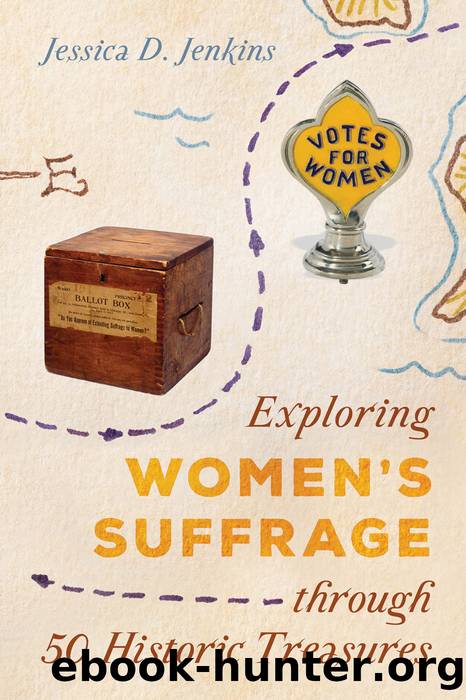Exploring Women's Suffrage through 50 Historic Treasures by Jessica D. Jenkins

Author:Jessica D. Jenkins
Language: eng
Format: epub
Publisher: Rowman & Littlefield Publishers
Published: 2020-03-11T00:00:00+00:00
29
A Formidable Opponent
Anti-Suffrage Pennant, 1900–1920, Lorenzo State Historic Site, Cazenovia, NY, https://parks.ny.gov/historic-sites/15/details.aspx
LORENZO STATE HISTORIC SITE, CAZENOVIA, NY, NEW YORK STATE OFFICE OF PARKS, RECREATION AND HISTORIC PRESERVATION
Comic book and action film fans know that when the name Batman is mentioned the character of the Joker quickly comes to mind. Since the Joker’s creation in 1940, the two comic book characters have existed together; each with their own view on life and constantly in a battle as archenemies. However, not all adversaries have a struggle as deadly as this hero and supervillain duo. While gaining the vote was seen as a matter of life or death by some suffragists, no one unleashed lethal joy buzzers, razor-edged playing cards, or acid-spraying lapel flowers. Instead, suffragists and their counterpart unleashed a war of carefully crafted words. In many ways, anti-suffragists resembled their opponent while disagreeing on the fundamental issue of voting rights. They organized into leagues, published their own newspapers, made their case to the public, and even produced items like the pennant seen on the previous page. When displayed or held aloft at public events, it allowed the owner, Charles S. Fairchild, to communicate his support of the anti-suffrage cause. Proudly working against women gaining the right to vote, Fairchild was not alone in Cazenovia, New York. Many of the community’s prominent residents considered themselves avid supporters of the anti-suffrage cause and the Cazenovia Anti-Suffrage Society became very active in the town.1 Like other organizations working against suffrage around the nation, Cazenovia’s anti-suffrage activities represented the formidable opponent suffragists faced from their earliest years until 1920.2
In the twenty-first century, it might be hard to imagine anti-suffragists as anyone but men. All women must have wanted to vote, right? Not necessarily. While plenty of men like Fairchild worked against women’s voting rights, women by-and-large led the anti-suffrage movement. Even at the time, suffragists often stated that men in powerful industries such as railroad and liquor led the opposition against them. In some instances, they may have believed it.3 In others, they knew it would directly undercut their own arguments to admit that not all women wanted the right to vote, so they knowingly placed the blame on men. Despite what suffragists wanted lawmakers to believe, a conservative countermovement existed alongside them, with a mostly female membership.4
From the beginnings of the suffrage movement women protesting female enfranchisement had always existed, even if only sporadically at first. As suffrage victories began to mount in the western states, however, women who did not believe their sex needed the right to vote began to organize at the local level for thoughtful, direct opposition. This defensive manner continued, and as the suffrage campaign intensified or slowed down, the anti-suffrage movement followed the same ebb and flow.5 When suffragists succeeded in securing state referenda, anti-suffragists quickly expanded their local societies to statewide organizations. Because the suffrage movement’s success was limited to state and local levels for so long, not until 1911 (when the suffrage movement began to intensify at
Download
This site does not store any files on its server. We only index and link to content provided by other sites. Please contact the content providers to delete copyright contents if any and email us, we'll remove relevant links or contents immediately.
| Civilization & Culture | Expeditions & Discoveries |
| Jewish | Maritime History & Piracy |
| Religious | Slavery & Emancipation |
| Women in History |
Cecilia; Or, Memoirs of an Heiress — Volume 1 by Fanny Burney(31331)
Cecilia; Or, Memoirs of an Heiress — Volume 3 by Fanny Burney(30933)
Cecilia; Or, Memoirs of an Heiress — Volume 2 by Fanny Burney(30889)
The Secret History by Donna Tartt(16618)
Sapiens: A Brief History of Humankind by Yuval Noah Harari(13047)
Leonardo da Vinci by Walter Isaacson(11901)
The Radium Girls by Kate Moore(10906)
Sapiens by Yuval Noah Harari(4534)
The Wind in My Hair by Masih Alinejad(4424)
How Democracies Die by Steven Levitsky & Daniel Ziblatt(4397)
Homo Deus: A Brief History of Tomorrow by Yuval Noah Harari(4276)
Endurance: Shackleton's Incredible Voyage by Alfred Lansing(3839)
The Silk Roads by Peter Frankopan(3758)
Man's Search for Meaning by Viktor Frankl(3630)
Millionaire: The Philanderer, Gambler, and Duelist Who Invented Modern Finance by Janet Gleeson(3568)
The Rape of Nanking by Iris Chang(3514)
Hitler in Los Angeles by Steven J. Ross(3435)
The Motorcycle Diaries by Ernesto Che Guevara(3332)
Joan of Arc by Mary Gordon(3257)
